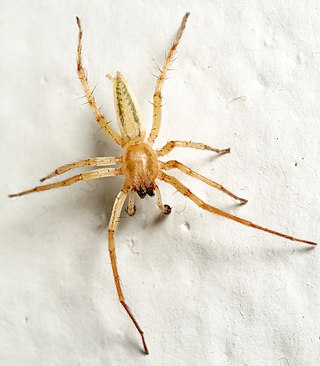
Anyphaenidae is a family of araneomorph spiders, sometimes called anyphaenid sac spiders. They are distinguished from the sac spiders of the family Clubionidae and other spiders by having the abdominal spiracle placed one third to one half of the way anterior to the spinnerets toward the epigastric furrow on the underside of the abdomen. In most spiders the spiracle is just anterior to the spinnerets.
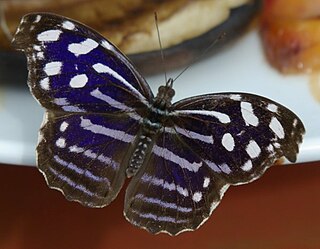
Biblidinae is a subfamily of nymphalid butterflies that includes the tropical brushfoots. This subfamily was sometimes merged within the Limenitidinae, but they are now recognized as quite distinct lineages. In older literature, this subfamily is sometimes called Eurytelinae.

The Argentine brown bat is a bat species from South and Central America.
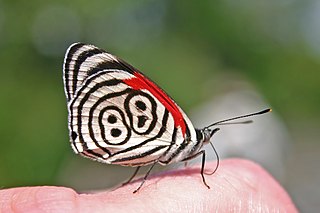
Diaethria anna, also known as Anna's eighty-eight or Finita Burrasca , is a butterfly in wet tropical forests in Middle America. On rare occasions, it can be found as a stray in south Texas. Its upperside is dark brown with a metallic bluish-green band on the forewings. The underside of the forewings are red, which is followed by a wide, black band and then white tips; the underside of the hindwings is white, with lines that approximate a black-outlined "88", giving the species its common name. Its markings occasionally appear more like of "98" or "89".

Callicore is a genus of nymphalid butterfly found in the Neotropical realm. This genus, like some related ones, was formerly lumped together as the paraphyletic Catagramma assemblage.

Diaethria is a brush-footed butterfly genus found in the Neotropical realm, ranging from Mexico to Paraguay.
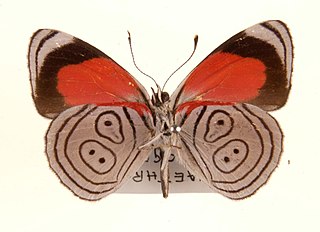
Diaethria phlogea, the 89'98 butterfly, is a species of butterfly of the family Nymphalidae. It is found in Colombia, South America.
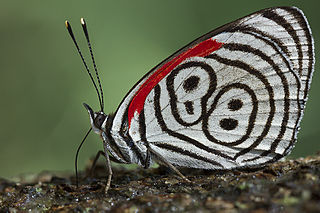
Diaethria eluina, the eluina eighty-eight, is a species of butterfly of the family Nymphalidae. It is found from Peru to Bolivia and Brazil.

Diaethria clymena, the Cramer's eighty-eight, is a species of butterfly of the family Nymphalidae. It is found from Mexico to Peru and Brazil. It was described to science by Pieter Cramer, in a fascicle of De uitlandsche Kapellen, 1775.
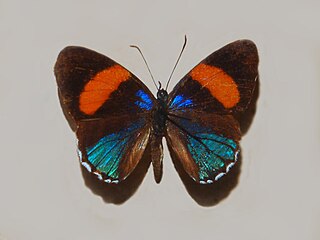
Callicore hydaspes, the Hydaspes eighty-eight or little callicore, is a species of butterfly of the family Nymphalidae.
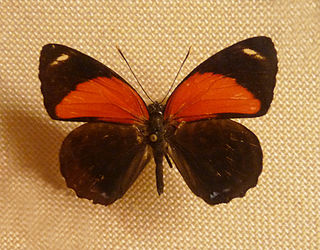
Catagramma pygas, the Godart's numberwing or pygas eighty-eight, is a species of butterfly of the family Nymphalidae. It is found in Venezuela, Guyana, Ecuador, Peru, Bolivia, Paraguay and the upper Amazonian region of Brazil.
Eighty-eights may refer to brush-footed butterflies in two genera:
Diaethria ceryx, the Ceryx eighty-eight, is a species of butterfly of the genus Diaethria. Diaethria ceryx was recorded for the first time in the coastal mountains in Manabí, Ecuador.
Diaethria bacchis is a species of butterfly of the genus Diaethria. It was described by Edward Doubleday in 1849. It is found in Mexico.

Diaethria euclides is a species of butterfly of the genus Diaethria. It was described by Pierre André Latreille in 1809. It is found from eastern Colombia to north-western Venezuela, western Ecuador and northwestern Peru.
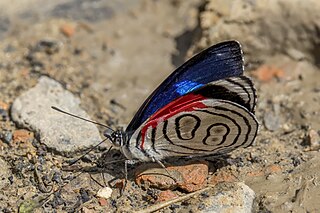
Diaethria gabaza is a species of butterfly of the genus Diaethria. It was described by William Chapman Hewitson in 1852. It is found from Costa Rica and Guatemala to Colombia, Ecuador and Venezuela.

Diaethria neglecta is a species of butterfly of the genus Diaethria. It was described by Osbert Salvin in 1869. It is found in Bolivia, Peru, Ecuador, Colombia and Venezuela. All Diaethria species are commonly called eighty-eights because of the patterns on the hindwing undersides.

Diaethria nystographa is a species of butterfly of the genus Diaethria. It was described by Achille Guenée in 1872. It is found in Peru, Ecuador, Colombia and Venezuela.

Xenoctenidae is a family of araneomorph spiders separated from Miturgidae in 2017.















